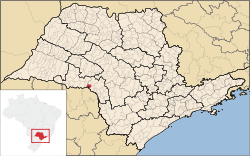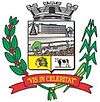Salto Grande, São Paulo
| Salto Grande | |||
|---|---|---|---|
| |||
|
Motto: VIS IN CELERITATE ("the driving force") | |||
 | |||
 Salto Grande Location in Brazil | |||
| Coordinates: 22°53′34″S 49°59′08″W / 22.89278°S 49.98556°WCoordinates: 22°53′34″S 49°59′08″W / 22.89278°S 49.98556°W | |||
| Country |
| ||
| Region | Southeast | ||
| State |
| ||
| Founded | 1911 | ||
| Government | |||
| • Mayor | Dirceu Feltrin (PTB (2013–2016)) | ||
| Area | |||
| • City | 189.072 km2 (73.001 sq mi) | ||
| Elevation | 436 m (1,430 ft) | ||
| Population (2010) | |||
| • City | 8,787 | ||
| • Density | 46/km2 (120/sq mi) | ||
| • Urban | 7,933 | ||
| • Rural | 854 | ||
| Demonym(s) | Saltograndense | ||
| Time zone | UTC-3 (UTC-3) | ||
| • Summer (DST) | UTC-2 (UTC-2) | ||
| Postal Code (CEP) | 19920-000 | ||
| Area code(s) | (+55) 14 | ||
| Website |
www | ||
Salto Grande is a municipality in the state of São Paulo in Brazil. The population in 2015 is 9.223 and the area is 189.072 km² (73.001 sq mi). The elevation is 436 m (1,430 ft).
Origin of the name
Due to the large waterfalls that existed in the city submersed by damming of rivers for the construction of the hydroelectric plant. First, the city was called the Cachoeira Dos Dourados, then by Salto Grande do Paranapanema and from 1922 Salto Grande.
History
Around 1843 the region was inhabited by Caiuás and Guarani Indians, entrusted to catechesis of Friar pacific of Monte Falco, brought from Italy by Antonina Baron, owner of extensive land grants in northern of Paraná and southern of São Paulo. José Teodoro de Souza, who years earlier had been interested in the lands, recorded in 1856 a possession that was beginning in Salto Grande's waterfall in the river Paranapanema, and went to the mouth of the river Tibagi.Em then promoted the local population with white and catechized Indians, for use in agricultural work. Thus was born the village of Salto Grande do Paranapanema, on a small column on the banks of the Paranapanema and Rio Novo rivers.
Demography
In 2014, Salto grande was the 383º most populous city in Brazil and according to the 2010 IBGE Census, there were 8,787 people residing in the city. The census found 6,054 White people (68,90%), 2,384 Pardo (multiracial) people (27,13%), 287 Black people (3,27%), 60 Asian people (0,68%) and 2 Amerindian people (0.02%).[1]
- Data of the Census of 2010
- Total population: 8.787
- Metro: 7.933 (90,3%)
- Rural: 854 (9,7%)
- Men: 4.353 (49,55%)
- Women: 4.434 (50,45%)
Population density (hab./km²): 46,64
Infant mortality up to 1 year (per thousand): 15.5
Infant mortality up to 5 year (per thousand): 18
Life expectancy (years): 74.5
Total fertility rate: 2.41
Literacy rate: 84,63%
Human Development Index (HDI): 0.704
- HDI GDP: 0.664
- HDI longevity: 0.825
- HDI education: 0.637
- Source: IPEAdata
Culture and leisure
Points of interest
Salto Grande because of its location, natural beauty and it contains a climate with well defined seasons, has a great tourism potential. The hot, dry and stable climate makes the city on the banks of the Paranapanema River, with its beautiful waters, is very popular for those who want to be in touch with nature, either by water sports, or simply for your other points of interest. They are:
The beach ("Prainha")
Located on the banks of the Paranapanema River, the beach of Salto Grande, affectionately called "Prainha" by the townspeople, is an artificial beach that has almost 4 km of long and is one of the main tourist points of the city. It is very visited by inhabitants of the region.
It is also used for water sports, using water bike, kayak, boat and paddle boats and the area has a barbecue site and a vast area for walking and hiking. Salto Grande earned the nickname "Cidade Praia" ("Beach city") because of the many visitors to the region visiting the beach, especially during its various events and festivals. [2]
Archaeological site
Discovered in 1990 by a team of University of São Paulo, have been found several pieces and indigenous funerary urns with over a thousand years old, where were buried (in the urns) bodies of Indians who lived in the region. These research aim to rebuild the characteristics of settlement over 8000 years and so study their way of life and their local customs.[2]
References
- ↑ Sidra (Sistema IBGE de Recuperação de Dados Automática) (2010). "Tabela 3175 - População residente, por cor ou raça, segundo a situação do domicílio, o sexo e a idade". Retrieved 9 June 2012.
- 1 2 Galvanin, Fátima (2005). Conto, Canto e Encanto com a Minha História... Salto Grande - Cidade Praia. São Paulo: Noovha America.

